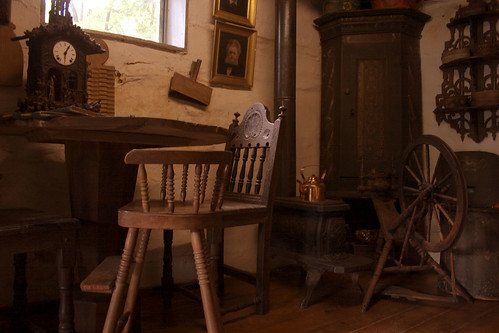Social Essays
Main Quarters

Bringing very few possessions with them from their homeland, Norwegians in Wisconsin would set to work at carving new possessions. They were master carvers, and made everything out of wood, including their cabins and furniture, right down to shovels and kitchen utensils.
The dark, long winters in Norway had given them many reasons to become craftsmen. They knew how to carve an unbroken, linked chain entirely out of wood, which they would then hang on the wall. The term "whittling away your time" likely stemmed from the idea that an entire winter could be passed in this manner.
Tailoring was largely left to the women. Norwegians made all of their clothes out of wool and linens. Often these clothes had been brought with them from their homeland. This included breastpins and brooches that were designed to be worn with the traditional, colorful folk costumes.
Wedding costumes - the garments to be worn for special occasions - were handsomely embroidered garments that had been handed down from generation to generation. They had deep religious and cultural significance.
Once in America, however, they had to adjust to a reliance on cotton, and wool that was considered inferior by Norwegian standards. Linen was seldom available. Women's clothing on the frontier became drab and utilitarian. Yankee Puritan influence also became a factor. Colorful clothes were associated with the sins of pride and vanity. The Americans believed that the plainer the costume, the more pleasing it was to the Almighty.
The dark, long winters in Norway had given them many reasons to become craftsmen. They knew how to carve an unbroken, linked chain entirely out of wood, which they would then hang on the wall. The term "whittling away your time" likely stemmed from the idea that an entire winter could be passed in this manner.
Tailoring was largely left to the women. Norwegians made all of their clothes out of wool and linens. Often these clothes had been brought with them from their homeland. This included breastpins and brooches that were designed to be worn with the traditional, colorful folk costumes.
Wedding costumes - the garments to be worn for special occasions - were handsomely embroidered garments that had been handed down from generation to generation. They had deep religious and cultural significance.
Once in America, however, they had to adjust to a reliance on cotton, and wool that was considered inferior by Norwegian standards. Linen was seldom available. Women's clothing on the frontier became drab and utilitarian. Yankee Puritan influence also became a factor. Colorful clothes were associated with the sins of pride and vanity. The Americans believed that the plainer the costume, the more pleasing it was to the Almighty.